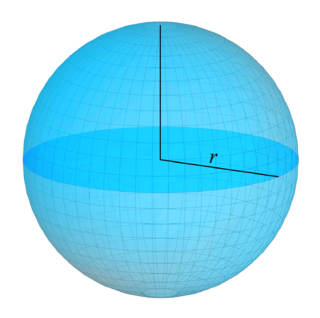
In mathematics, particularly in algebraic geometry, complex analysis and algebraic number theory, an abelian variety is a projective algebraic variety that is also an algebraic group, i.e., has a group law that can be defined by regular functions. Abelian varieties are at the same time among the most studied objects in algebraic geometry and indispensable tools for much research on other topics in algebraic geometry and number theory.

Algebraic varieties are the central objects of study in algebraic geometry. Classically, an algebraic variety is defined as the set of solutions of a system of polynomial equations over the real or complex numbers. Modern definitions generalize this concept in several different ways, while attempting to preserve the geometric intuition behind the original definition.

In mathematics, birational geometry is a field of algebraic geometry in which the goal is to determine when two algebraic varieties are isomorphic outside lower-dimensional subsets. This amounts to studying mappings that are given by rational functions rather than polynomials; the map may fail to be defined where the rational functions have poles.
In relation with the history of mathematics, the Italian school of algebraic geometry refers to the work over half a century or more done internationally in birational geometry, particularly on algebraic surfaces. There were in the region of 30 to 40 leading mathematicians who made major contributions, about half of those being in fact Italian. The leadership fell to the group in Rome of Guido Castelnuovo, Federigo Enriques and Francesco Severi, who were involved in some of the deepest discoveries, as well as setting the style.

David Bryant Mumford is an American mathematician known for distinguished work in algebraic geometry, and then for research into vision and pattern theory. He won the Fields Medal and was a MacArthur Fellow. In 2010 he was awarded the National Medal of Science. He is currently a University Professor Emeritus in the Division of Applied Mathematics at Brown University.
In geometry, a hypersurface is a generalization of the concepts of hyperplane, plane curve, and surface. A hypersurface is a manifold or an algebraic variety of dimension n − 1, which is embedded in an ambient space of dimension n, generally a Euclidean space, an affine space or a projective space. Hypersurfaces share, with surfaces in a three-dimensional space, the property of being defined by a single implicit equation, at least locally, and sometimes globally.
In mathematics, the Torelli theorem, named after Ruggiero Torelli, is a classical result of algebraic geometry over the complex number field, stating that a non-singular projective algebraic curve C is determined by its Jacobian variety J(C), when the latter is given in the form of a principally polarized abelian variety. In other words, the complex torus J(C), with certain 'markings', is enough to recover C. The same statement holds over any algebraically closed field. From more precise information on the constructed isomorphism of the curves it follows that if the canonically principally polarized Jacobian varieties of curves of genus are k-isomorphic for k any perfect field, so are the curves.
In mathematics, the theta divisor Θ is the divisor in the sense of algebraic geometry defined on an abelian variety A over the complex numbers by the zero locus of the associated Riemann theta-function. It is therefore an algebraic subvariety of A of dimension dim A − 1.
In mathematics, the Schottky problem, named after Friedrich Schottky, is a classical question of algebraic geometry, asking for a characterisation of Jacobian varieties amongst abelian varieties.

In mathematics, a surface is a generalization of a plane which needs not be flat – that is, the curvature is not necessarily zero. This is analogous to a curve generalizing a straight line. There are several more precise definitions, depending on the context and the mathematical tools that are used for the study.
In algebraic geometry, a branch of mathematics, a Hilbert scheme is a scheme that is the parameter space for the closed subschemes of some projective space, refining the Chow variety. The Hilbert scheme is a disjoint union of projective subschemes corresponding to Hilbert polynomials. The basic theory of Hilbert schemes was developed by Alexander Grothendieck (1961). Hironaka's example shows that non-projective varieties need not have Hilbert schemes.
In algebraic geometry, the minimal model program is part of the birational classification of algebraic varieties. Its goal is to construct a birational model of any complex projective variety which is as simple as possible. The subject has its origins in the classical birational geometry of surfaces studied by the Italian school, and is currently an active research area within algebraic geometry.
Arthur Byron Coble was an American mathematician. He did research on finite geometries and the group theory related to them, Cremona transformations associated with the Galois theory of equations, and the relations between hyperelliptic theta functions, irrational binary invariants, the Weddle surface and the Kummer surface. He was President of the American Mathematical Society from 1933 to 1934.
In algebraic geometry, a line complex is a 3-fold given by the intersection of the Grassmannian G(2, 4) with a hypersurface. It is called a line complex because points of G(2, 4) correspond to lines in P3, so a line complex can be thought of as a 3-dimensional family of lines in P3. The linear line complex and quadric line complex are the cases when the hypersurface has degree 1 or 2; they are both rational varieties.
Foundations of Algebraic Geometry is a book by André Weil that develops algebraic geometry over fields of any characteristic. In particular it gives a careful treatment of intersection theory by defining the local intersection multiplicity of two subvarieties.
The terminology of algebraic geometry changed drastically during the twentieth century, with the introduction of the general methods, initiated by David Hilbert and the Italian school of algebraic geometry in the beginning of the century, and later formalized by André Weil, Jean-Pierre Serre and Alexander Grothendieck. Much of the classical terminology, mainly based on case study, was simply abandoned, with the result that books and papers written before this time can be hard to read. This article lists some of this classical terminology, and describes some of the changes in conventions.
In mathematics, the Wirtinger plane sextic curve, studied by Wirtinger, is a degree 6 genus 4 plane curve with double points at the 6 vertices of a complete quadrilateral.

arXiv is a repository of electronic preprints approved for posting after moderation, but not full peer review. It consists of scientific papers in the fields of mathematics, physics, astronomy, electrical engineering, computer science, quantitative biology, statistics, mathematical finance and economics, which can be accessed online. In many fields of mathematics and physics, almost all scientific papers are self-archived on the arXiv repository. Begun on August 14, 1991, arXiv.org passed the half-million-article milestone on October 3, 2008, and had hit a million by the end of 2014. By October 2016 the submission rate had grown to more than 10,000 per month.

In computing, a Digital Object Identifier or DOI is a persistent identifier or handle used to uniquely identify objects, standardized by the International Organization for Standardization (ISO). An implementation of the Handle System, DOIs are in wide use mainly to identify academic, professional, and government information, such as journal articles, research reports and data sets, and official publications though they also have been used to identify other types of information resources, such as commercial videos.

An International Standard Serial Number (ISSN) is an eight-digit serial number used to uniquely identify a serial publication, such as a magazine. The ISSN is especially helpful in distinguishing between serials with the same title. ISSN are used in ordering, cataloging, interlibrary loans, and other practices in connection with serial literature.










